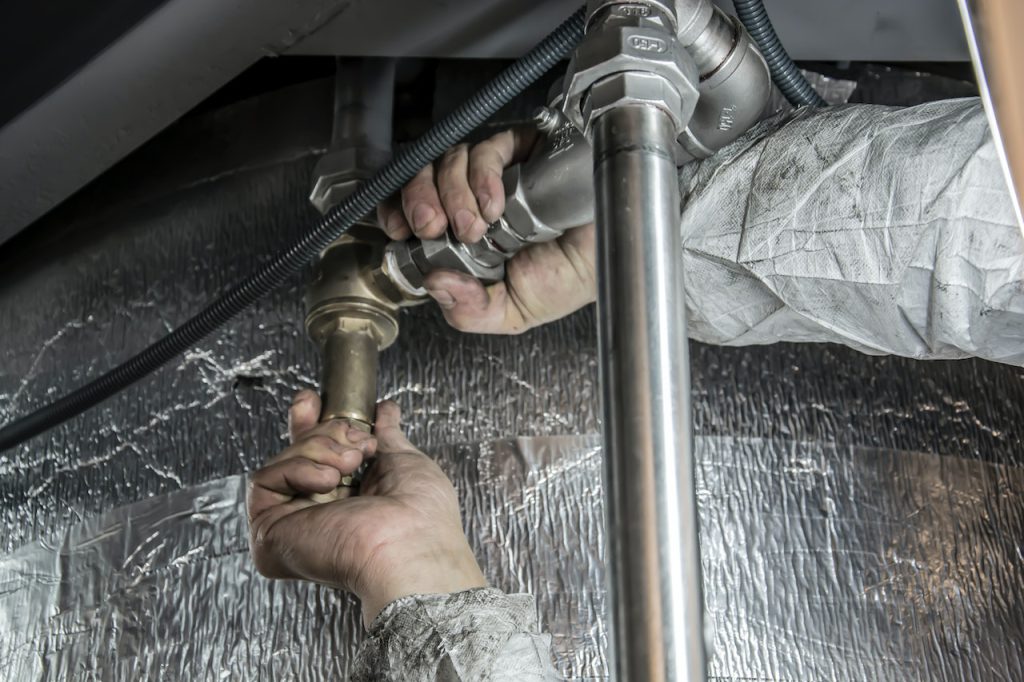Did you know that 10% of household water usage is due to plumbing leaks? Whether you’re a new homeowner or just starting to take on maintenance tasks, understanding the basics of plumbing work can be a game-changer for water usage. Plumbing maintenance not only saves time but also prevents costly repairs down the road. By learning these plumbing tips and fundamentals, you can avoid potential disasters and make informed decisions when hiring licensed plumbers for complex tasks.
Table of Contents
ToggleBuilding Your Emergency Plumbing Toolkit
a. Essential Items
Having a well-stocked emergency toolkit is crucial. You never know when unexpected plumbing maintenance issues might arise, so being prepared with the right tools can make all the difference. Some essential items for plumbing maintenance include a plunger, pipe wrench, plumber’s tape, and a flashlight. These tools are fundamental for addressing minor plumbing problems on your own.
Having a plunger is vital for plumbing maintenance and dealing with clogged toilets or sinks. It creates suction that helps dislodge blockages, making it an indispensable tool for any homeowner in plumbing maintenance. A sturdy and adjustable pipe wrench allows you to grip and turn pipes, fittings, and fixtures securely during repair or maintenance tasks. Keeping some high-quality plumber’s tape and plumbing maintenance in your toolkit can help prevent leaks in threaded pipe joints by providing a tight seal. Lastly, a reliable flashlight is essential for illuminating dark areas under sinks or behind appliances where plumbing work may be required.
b. Additional Considerations
In addition to the aforementioned essentials, consider including other useful items in your emergency plumbing toolkit such as an adjustable wrench, duct tape, and a bucket. An adjustable wrench and duct tape can be handy for various plumbing maintenance tasks like tightening nuts and bolts and serving as a temporary fix for small leaks until permanent repairs can be made.
A sturdy bucket is also beneficial for plumbing maintenance when dealing with water-related issues as it can be used to collect excess water from leaks or drips during repairs. Moreover, keeping some spare parts like washers and O-rings could prove helpful if you encounter worn-out components during maintenance activities.
Mastering Water Shut-Off And Leak Check Procedures
a. Importance of Water Shut-Off
Knowing how to shut off the water supply for plumbing maintenance in your home is crucial for emergencies or repairs. In case of a burst pipe or major leak, being able to quickly turn off the water can prevent extensive damage to your property and plumbing maintenance. It’s also essential for conducting plumbing maintenance tasks like replacing fixtures or repairing pipes.
Being familiar with the location of the main water shut-off valve is key for plumbing maintenance. Typically, it’s located near the perimeter of your property where the water line enters. In some homes, it may be found in a basement, crawl space, utility room, or near an outdoor faucet. Familiarize yourself with its location and ensure that everyone in your household knows how to operate it.
In addition to knowing about the main shut-off valve, understanding how to isolate individual fixtures such as sinks and toilets can also be beneficial during minor repairs or maintenance activities.
b. Conducting Regular Leak Checks
Regularly checking for small leaks throughout your plumbing system is vital for preventing extensive water damage and costly repairs down the road. Even seemingly minor drips from faucets or small leaks under sinks can lead to mold growth, structural damage, and increased water bills over time.
Start by inspecting visible pipes under sinks and around appliances that use water (like dishwashers). Look out for any signs of moisture accumulation or corrosion on fittings. Monitor your water meter when no one is using any water in your home; if it continues running despite no active usage, there might be an undetected leak somewhere in your plumbing system.
It’s advisable to address small leaks promptly before they escalate into larger issues that require professional intervention.
Understanding Your Home’s Plumbing System And History
a. Familiarizing Yourself
Understanding the water flow and layout of your home’s plumbing system is crucial for effective troubleshooting. Knowing where the main shut-off valve, pipes, and fixtures are located can help you address issues promptly. For instance, if a specific area in your house experiences low water pressure, understanding the layout can aid in identifying potential blockages or leaks within that section.
Familiarizing yourself with the entire home plumbing system also enables you to pinpoint areas that may require regular maintenance or upgrades. By being aware of the distribution of pipes and fixtures throughout your house, you can anticipate potential problems such as aging pipes or outdated fittings.
b. Learning About History
Learning about your home’s plumbing history provides valuable insights into its current condition. If your house is older, understanding when certain plumbing components were installed can alert you to potential issues due to wear and tear over time. For example, knowing that your piping system hasn’t been updated in several decades may prompt you to inspect it more frequently for signs of deterioration.
Moreover, being informed about the historical changes made to your plumbing system allows you to make informed decisions regarding necessary upgrades or replacements. If parts of your plumbing are outdated or have a history of recurring issues, this knowledge empowers you to proactively invest in modern solutions for better efficiency and longevity.
Daily And Weekly Drain Maintenance Practices
a. Using Drain Screens
Implementing simple daily practices like using drain screens can prevent clogs. These screens catch hair, soap scum, and other debris before they enter the drain, reducing the likelihood of blockages. By preventing these substances from accumulating in your pipes, you can avoid costly plumbing repairs.
Regularly cleaning drains using natural remedies like baking soda and vinegar can maintain their efficiency. Pouring boiling water down the drain after applying this mixture helps to clear any remaining debris. This method is not only effective but also environmentally friendly, as it doesn’t involve harsh chemicals that could damage your pipes.
b. Avoid Pouring Grease Down Drains
Another essential practice for new users is to avoid pouring grease down drains. When grease cools, it solidifies and sticks to pipe walls, leading to clogs over time. Instead of pouring it down the sink, collect grease in a container and dispose of it properly in the trash.
Regular maintenance of your home’s drainage system ensures smooth operation and prevents potential issues such as foul odors or slow drainage. Implementing these easy-to-follow daily and weekly drain maintenance routines will help you keep your plumbing system in top condition without having to rely on professional assistance frequently.

Garbage Disposal And Waste Management Tips
a. Proper Usage
It’s crucial to use it properly. Avoid putting fibrous or starchy foods, like banana peels or potato skins, into the disposal. These items can clog the system and cause damage over time. Instead, dispose of these items in the trash to prevent any potential harm.
Implementing effective waste management practices is essential for maintaining a healthy plumbing system. For instance, using compost bins for organic waste helps reduce strain on your garbage disposal and prevents blockages in your drains. By doing so, you’re not only safeguarding your plumbing but also contributing to environmental sustainability by reducing landfill waste.
b. Regular Maintenance
Regularly maintaining your garbage disposal ensures its longevity and proper function. One way to do this is by running cold water while using the disposal and for a short period afterward. This helps flush out any remaining food particles that could potentially cause clogs if left unattended.
Another helpful tip is to clean the garbage disposal with natural solutions such as baking soda and vinegar. This not only eliminates odors but also helps break down grease buildup inside the unit, keeping it in good working condition.
Seasonal Plumbing Maintenance and Winterization
a. Different Seasons
Each season brings specific plumbing maintenance tasks. For instance, during winter, it’s crucial to insulate pipes to prevent freezing. In the spring, checking outdoor faucets and sprinkler systems is essential to avoid leaks or damage.
As the temperatures change throughout the year, your plumbing system requires different care. During colder months, protecting your pipes from freezing is vital. This involves insulating exposed pipes with foam sleeves or wrapping them with heat tape.
Checking for leaks in outdoor faucets before each season can help you avoid water wastage and potential damage. It’s important to ensure that all outdoor plumbing fixtures are in good condition before extreme weather hits.
b. Regular Inspection
Regularly examining your plumbing system before each season can save you from costly repairs down the line. Checking for any signs of wear and tear on hoses, valves, and connections is crucial for preventing unexpected leaks or bursts.
Inspecting indoor plumbing fixtures like sinks, showers, toilets, and washing machine hoses should be part of your regular routine as well. Look out for any signs of corrosion or mineral buildup that could lead to clogs or leaks.
It’s also important to monitor your water usage during different seasons. For example, if you notice a sudden increase in water consumption during the summer months when you’re not watering plants more frequently than usual, there might be an undetected leak somewhere in your system.
c. Winterization Techniques
Winterizing your plumbing system is essential to prevent frozen pipes and potential water damage during cold spells. One effective technique is allowing a small trickle of water to flow through both hot and cold taps during extremely cold nights.
Another winterization technique involves disconnecting garden hoses from outdoor faucets and draining any remaining water from the spigots. Failing to do so can result in frozen pipes inside the house.
To further protect against freezing temperatures, consider installing frost-free hose bibs outside your home. These specialized faucets are designed to prevent standing water within the pipe where it connects with the exterior wall—reducing the risk of freezing even without disconnecting hoses.
Recognizing and Addressing Common Plumbing Issues
a. Identifying Common Problems
Recognizing the warning signs is crucial. Dripping faucets, running toilets, or slow drainage are common issues that many homeowners face. These seemingly minor problems can lead to major plumbing issues if left unattended. For instance, a dripping faucet may seem insignificant, but over time, it can waste gallons of water and result in higher utility bills.
Understanding these common plumbing problems empowers you to take action promptly. By recognizing the early signs of trouble, you can address them before they escalate into more significant issues. Being able to identify these problems will help you communicate effectively with professional plumbers when seeking assistance.
b. Understanding Causes And Solutions
Knowing the causes behind these problems is equally important as identifying them. For example, understanding that fluctuating water pressure could be causing your pipes to make unusual noises can aid in troubleshooting the issue effectively.
By addressing common plumbing problems promptly and understanding their root causes, you’ll save both time and money in the long run — preventing small issues from turning into costly repairs or replacements down the line.
c. Examples Of Common Issues
- Dripping Faucets: A worn-out washer or O-ring is often the culprit behind a dripping faucet.
- Running Toilets: This issue typically arises due to a faulty flapper valve that fails to seal properly after flushing.
- Slow Drainage: Hair buildup or foreign objects lodged in the drain pipe are frequent causes of slow drainage.
d. Solutions for Resolving Issues
Addressing these plumbing concerns often requires simple solutions that first-time users can handle themselves without professional assistance:
- Replacing worn-out washers or O-rings for dripping faucets.
- Adjusting or replacing faulty flapper valves for running toilets.
- Using a drain snake tool or pouring hot water down drains to clear clogs causing slow drainage.
Establishing Preventive Plumbing Care Routines
a. Regular Inspections
Regular inspections are crucial for identifying potential issues before they become major problems. By inspecting your pipes and water heater periodically, you can catch leaks, corrosion, or other damage early on. This allows you to address these issues promptly, preventing costly repairs down the line.
Implementing preventive care routines like regular pipe inspections and water heater maintenance can extend their lifespan. It’s important to check for any signs of leaks, rust, or unusual noises coming from the water heater. Addressing these problems early can prevent them from escalating into more significant issues that require professional intervention.
b. Cleaning Showerheads And Aerators
In addition to regular inspections, it’s essential to focus on cleaning showerheads and aerators regularly. Over time, mineral deposits can accumulate in these fixtures, leading to reduced water flow and uneven spray patterns. By removing the showerhead and soaking it in vinegar or a commercial descaling solution, you can dissolve these deposits and restore proper water flow.
Regularly cleaning showerheads and aerators can prevent mineral buildup and maintain water flow. You should also check for any clogs in the aerator by unscrewing it from the faucet spout and rinsing away any debris that may be obstructing the flow of water.
Conclusion
You’ve now armed yourself with the essential knowledge and tools to take charge of your plumbing maintenance. By mastering water shut-off procedures, understanding your home’s plumbing system, and establishing preventive care routines, you’re well-prepared to tackle common issues and prevent emergencies. Remember, proactive maintenance not only saves you from costly repairs but also ensures the smooth functioning of your home’s vital systems. So, don’t wait for a leak to become a flood – take proactive steps today to keep your plumbing in top shape.
Now that you’re equipped with these insights, it’s time to put them into action. Take a stroll through your home, check for potential issues, and implement the maintenance practices you’ve learned. Your proactive approach will not only save you money but also provide peace of mind, knowing that your plumbing is well taken care of. Happy plumbing!
Frequently Asked Questions
1. I’m New To Plumbing Maintenance. Where Should I Start?
Start by familiarizing yourself with your home’s plumbing system and its components. Learn how to shut off the main water supply in case of emergencies, and build an emergency plumbing toolkit with essential tools like a plunger, wrench, and plumber’s tape.
2. How Often Should I Perform Drain Maintenance?
It’s best to incorporate weekly practices such as using a hair catcher in the shower and flushing drains with hot water. Schedule a monthly deep clean using natural solutions like baking soda and vinegar to prevent clogs and maintain smooth drainage.
3. What Are Some Common Signs Of Plumbing Issues?
Keep an eye out for slow drainage, low water pressure, unusual odors from drains, or unexplained spikes in your water bill. These could indicate potential problems that need attention from a professional plumber before they escalate into larger issues.
4. How Can I Prepare My Plumbing For Winter?
Before winter sets in, insulate exposed pipes and disconnect garden hoses to prevent freezing. Familiarize yourself with how to shut off outdoor faucets if necessary. It’s also wise to have a professional inspect your heating system before the cold weather arrives.
5. Why Is Proactive Plumbing Maintenance Important?
Regular maintenance helps you catch small issues before they become major problems that require costly repairs. Just as you take care of your car with regular oil changes to avoid breakdowns on the road, proactive plumbing care ensures smooth operation without unexpected disruptions or expenses down the line.
Experience Top-Notch Preventive Plumbing Maintenance with Garcia Home Restoration!
At Garcia Home Restoration, we recognize the importance of maintaining a healthy and efficient plumbing system in your home. Our team, known for their proficiency in Preventive Plumbing Maintenance, is committed to ensuring the longevity and reliability of your plumbing infrastructure. Our focus at Garcia Home Restoration goes beyond mere fixes; we strive to enhance the overall functionality and safety of your home’s plumbing system. We have built a remarkable reputation in Contra Costa County for our dedication to quality, our extensive knowledge of plumbing maintenance, and the trust we’ve established with numerous satisfied customers. Don’t let plumbing issues disrupt your home’s comfort and safety. Contact us today for exceptional Preventive Plumbing Maintenance services and enjoy the assurance of a well-maintained plumbing system in your home!




